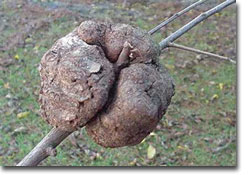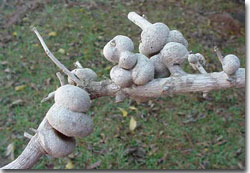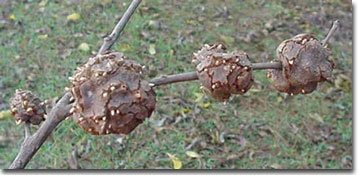Galls are abnormal swellings of plant tissue. They can have different sizes and shapes and can be located on different parts of plants or trees. Most galls on trees are produced by wasps and mites, but can also be caused by fungi, bacteria and nematodes. Galls can be found on several species of trees. Different factors, such as weather, tree species and pest populations, affect the occurrence of galls each year.
Galls commonly occur on oak trees in Texas. Growth deformities known as galls commonly occur on oak trees in Texas. Most oak trees are attacked by a group of small insects called gall makers. These insects can cause deformities, called galls, in the leaves, twigs, bark, buds, flowers, nuts, or roots of the tree. Because of the unusual size and shape of the horned oak gall and the gouty oak gall, they attract the attention of landowners and homeowners who are concerned about what causes the galls and what harm or damage they will do to oak trees. The horned oak gall and gouty oak gall are most commonly seen in East Texas. Each of these galls is caused by a tiny wasp that has a complicated and poorly understood life cycle. Both types of galls are globular in shape, are hard and woody, and they may be two or more inches in diameter. Horned oak galls will have short spikes (horns) protruding from them. Both galls commonly form on small branches (about one-fourth to one-half inch in diameter). In spite of the large size of many of these galls, they usually cause little if any serious harm to the trees. Sometimes twigs and small branches may die because the gall will girdle the branch as it grows around it.
Also, branches may droop from the weight of the galls. Although horned oak gall and gouty oak gall have been reported to kill trees, this has not been observed in East Texas.

Oak trees may be infected with gouty oak gall. A large, persistent, woody gall like this is evidence that a gall wasp has visited this branch. These galls may cause some branch dieback, but it is unlikely they would kill the tree.
Control for these insects is difficult. Because of their complicated life cycle, spraying with an insecticide is usually not effective and therefore not recommended. There may be some value in pruning branches that contain galls, but doing nothing is probably the best alternative.
The wasps that cause horned oak gall and gouty oak gall are commonly called cynipid gall wasps (family Cynipidae, genus Callirhytis). The small adult wasps are seldom seen. The life cycle of these wasps is not well understood, but has been reported as follows. In spring and early summer, tiny wasps (all females) emerge from the fully developed woody galls on twigs or branches. These females then deposit eggs in the larger veins on the underside of oak leaves. These eggs soon hatch and the larvae (tiny grubs) cause small, oblong, blister-like galls to develop in the leaf veins. By midsummer, the larvae in the leaf galls have matured and pupated. From these pupae, male and female adult wasps emerge which then mate and deposit eggs in young oak twigs. The woody galls from this generation of wasps will not appear on the twigs until the next spring or early summer. It may take from one to three years for the larvae living in the woody twig galls to mature.

This picture shows a heavy infestation of gouty oak gall on the branch of a live oak tree.
The wasps that cause horned oak gall and gouty oak gall have an unusual life cycle involving alternating generations. In successive generations, these wasps produce two distinct types of galls. In addition, the adult wasps in these successive generations look quite different. In effect, the adult wasps look like their grandparents rather than their parents. Because of this unique behavior, which also may include alternate food plants, entomologists have yet to unravel the true identity of many gall wasps.
Insect-induced plant galls are usually caused by growth-regulating chemicals produced by the insect. When these chemicals react with plant hormones, profuse plant tissue growth occurs and the galls develop. The inner portion of each gall is rich in protein and provides the insect larvae inside the gall with a nutritious source of food. In addition, the wasp larvae developing inside the galls are protected from parasites, predators, and insecticides.

The horned oak gall gets its name because of the small spikes or horns that develop on the gall. Like the gouty oak gall, these galls are woody and can persist on the tree for several years.
Of the more than 700 species of gall-forming insects listed from the United States and Canada, nearly 80% are reported to form galls on oaks. Most gall insects can be identified by the uniquely-shaped galls they produce.
Texas A&M Forest Service can provide assistance concerning tree health problems. For further information, contact your nearest Texas A&M Forest Service office.